A Reversible Data-Hiding Method with Prediction-Error Expansion in Compressible Encrypted Images
Abstract
1. Introduction
2. Related Work
2.1. RDH Methods
2.2. RDH-EI Methods
2.3. Encryption-then-Compression Images
- Step 1:
- Transform an original image I from RGB into YCbCr.
- Step 2:
- Combine YCbCr channels into a single grayscale image .
- Step 3:
- Divide into a certain size of blocks.
- Step 4:
- Conduct position scrambling, block rotation or flip, and negative–positive transformation on each block.
- Step 5:
- Integrate all blocks and derive an encrypted image .
3. Proposed Method
3.1. Framework of Proposed Method
3.2. Procedure of Encryption and Data hiding
3.2.1. Image Encryption
- Step1-1:
- Combine R, G, and B components of an original image I, and a grayscale-based image is derived.
- Step1-2:
- Divide into multiple blocks with pixels.
- Step1-3:
- Conduct position scrambling, block rotation or flip, and negative–positive transformation on each block, and obtain an encrypted image .
3.2.2. Data Hiding
- Histogram modification: Since PEE-HS is used for data hiding, overflow (OF) or underflow (UF) may be caused in the value of each pixel. With the following steps, our method preliminarily modifies an image histogram in order to prevent OFs and UFs in pixel values.
- Step2-1:
- Explore a zero point () that is a bin with no pixels in an encrypted image histogram.
- Step2-2:
- To prevent UFs, add 1 to pixels with a value lower than .
- Step2-3:
- Repeat Steps 2-1 and 2-2 times. Here, L is a threshold used in data hiding.
- Step2-4:
- Explore a in the image histogram.
- Step2-5:
- To prevent OFs, subtract 1 from pixels with a value higher than .
- Step2-6:
- Repeat Steps 2-4 and 2-5 times.
We needed to exclude eight pixels from the top-left corner of encrypted images from the above steps and the following data-hiding process. An 8-bit value of threshold L was embedded into these pixels. Additionally, if there was no in the histogram, we focused on two neighboring bins with the lowest sum of frequencies. These bins were integrated into a single bin, and another bin was emptied (). We built a location map where the original pixel values with the two neighboring bins were recorded in order to identify their original pixel values in the restoration process. It is necessary to embed the value of or with an arbitrary payload to perfectly retrieve the original image. In the case of , the location map should be stored along with . - Prediction-error expansion and histogram shifting: We extended an RDH method on the basis of PEE-HS for stereoimages [16] and incorporated it into the proposed method. Our method embeds payload bits into each block, which is the same block as that in the encryption process. We describe the data-hiding procedure as follows.
- Step3-1:
- For pixels in each block, where and , predicted values are derived fromThe top-left pixel in each block was excluded from data hiding for reversibility.
- Step3-2:
- Derive prediction errors :
- Step3-3:
- in the prediction-error histogram, empty bins are derived in the range of and in accordance with the following equation.where denotes the prediction error after shifting. Figure 6a shows an example of a histogram shift in the case of .
- Step3-4:
- Step3-5:
- in the case of , embed the payload bits as follows (see Figure 6d).
- Step3-6:
- In this case, is updated by (8).
- Step3-7:
- Marked pixel values are given by
- Block integration: lastly, we integrate all the blocks into a marked encrypted image .
3.3. Procedure of Restoration
3.4. Threat Models and Security Evaluation
3.5. Advantages of Proposed Method
- High hiding capacityThe proposed method encrypts a target image in units of blocks, so interpixel correlation in each block can be stable before or after encryption. Since we could obtain prediction values with high accuracy in the encrypted domain, the hiding capacity of our method was around 1 bpp using PEE-HS. The proposed method has high hiding capacity, so we could embed not only copyright information and time stamps, but also information on image content, e.g., categorical and annotation data. With such information, we could determine the type of target images in the encrypted domain.
- Effective compression performanceThe proposed method preserves the interpixel correlation in each block after encryption and data hiding. Thus, international standards for lossless image compression, such as JPEG-LS and JPEG 2000, can be effectively utilized for the marked encrypted images produced by our method. Consequently, the proposed method alleviates the constraint on transmission and storage.
- Flexible restorationWhile the conventional method [29] has to extract the payload before decryption, our method could omit the data extraction process and decrypt only marked encrypted images in common with the conventional method [30]. The flexible restoration process provides a user with any one of the following three types of privilege: data extraction and decryption, data extraction only, and decryption only. This advantage allows for us to expand the range of applications.
4. Experimental Results
4.1. Data-Hiding Capacity and Marked-Image Quality
4.2. Lossless Compression Performance
5. Conclusions
Author Contributions
Funding
Institutional Review Board Statement
Informed Consent Statement
Data Availability Statement
Conflicts of Interest
References
- Shi, Y.Q.; Li, X.; Zhang, X.; Wu, H.T.; Ma, B. Reversible data hiding: Advances in the past two decades. IEEE Access 2016, 4, 3210–3237. [Google Scholar] [CrossRef]
- Tian, J. Wavelet-Based Reversible Watermarking for Authentication. Secur. Watermarking Multimed. Contents IV 2002, 4675, 679–690. [Google Scholar]
- Ni, Z.; Shi, Y.Q.; Ansari, N.; Su, W. Reversible data hiding. IEEE Trans. Circuits Syst. Video Technol. 2006, 16, 354–362. [Google Scholar]
- Fujiyoshi, M.; Sato, S.; Jin, H.L.; Kiya, H. A Location-Map Free Reversible Data Hiding Method using Block-Based Single Parameter. In Proceedings of the IEEE International Conference on Image Processing, San Antonio, TX, USA, 16 September–19 October 2007; pp. 257–260. [Google Scholar]
- Weng, S.; Shi, Y.Q.; Hong, W.; Yao, Y. Dynamic improved pixel value ordering reversible data hiding. Inf. Sci. 2019, 489, 136–154. [Google Scholar] [CrossRef]
- Wang, J.; Chen, X.; Ni, J.; Mao, N.; Shi, Y. Multiple histograms-based reversible data hiding: Framework and realization. IEEE Trans. Circuits Syst. Video Technol. 2020, 30, 2313–2328. [Google Scholar] [CrossRef]
- He, W.; Xiong, G.; Wang, Y. Reversible Data Hiding Based on Adaptive Multiple Histograms Modification. IEEE Trans. Inf. Forensics Secur. 2021, 16, 3000–3012. [Google Scholar] [CrossRef]
- Kim, S.; Qu, X.; Sachnev, V.; Kim, H.J. Skewed Histogram Shifting for Reversible Data Hiding Using a Pair of Extreme Predictions. IEEE Trans. Circuits Syst. Video Technol. 2019, 29, 3236–3246. [Google Scholar] [CrossRef]
- Zhang, T.; Li, W.; Qi, W.; Guo, Z. Location-Based PVO and Adaptive Pairwise Modification for Efficient Reversible Data Hiding. IEEE Trans. Inf. Forensics Secur. 2020, 15, 2306–2319. [Google Scholar] [CrossRef]
- Qu, B.; Li, X.; Zhang, W.; Zhao, Y. Improving Pairwise PEE via Hybrid-Dimensional Histogram Generation and Adaptive Mapping Selection. IEEE Trans. Circuits Syst. Video Technol. 2019, 29, 2176–2190. [Google Scholar]
- Hassan, F.S.; Gutub, A. Efficient Image Reversible Data Hiding Technique Based on Interpolation Optimization. Arab. J. Sci. Eng. 2021, 46, 8441–8456. [Google Scholar] [CrossRef]
- Hassan, F.S.; Gutub, A. Novel embedding secrecy within images utilizing an improved interpolation-based reversible data hiding scheme. J. King Saud Univ. Comput. Inf. Sci. 2022, 34, 2017–2030. [Google Scholar] [CrossRef]
- Gao, X.; Pan, Z.; Gao, E.; Fan, F. Reversible data hiding for high dynamic range images using two-dimensional prediction-error histogram of the second time prediction. Signal Process. 2020, 173, 107579. [Google Scholar] [CrossRef]
- He, X.; Zhang, W.; Zhang, H.; Ma, L.; Li, Y. Reversible data hiding for high dynamic range images using edge information. Multimedia Tools Appl. 2019, 78, 29137–29160. [Google Scholar] [CrossRef]
- Bhardwaj, R. Efficient separable reversible data hiding algorithm for compressed 3D mesh models. Biomed. Signal Process. Control. 2022, 73, 103265. [Google Scholar] [CrossRef]
- Lue, T.; Jiang, G.; Shao, F.; Peng, Z. Disparity based stereo image reversible data hiding. In Proceedings of the IEEE International Conference on Image Processing, Paris, France, 27–30 October 2014; pp. 5492–5496. [Google Scholar]
- Puteaux, P.; Ong, S.Y.; Wong, K.S.; Puech, W. A survey of reversible data hiding in encrypted images—The first 12 years. J. Vis. Commun. Image Represent. 2021, 77, 103085. [Google Scholar] [CrossRef]
- Zhang, X. Reversible data hiding in encrypted image. IEEE Signal Process. Lett. 2011, 18, 255–258. [Google Scholar] [CrossRef]
- Hong, W.; Chen, T.; Wu, H. An Improved Reversible Data Hiding in Encrypted Images Using Side Match. IEEE Signal Process. Lett. 2012, 19, 199–202. [Google Scholar] [CrossRef]
- Zhang, X. Separable reversible data hiding in encrypted image. IEEE Trans. Inf. Forensics Secur. 2012, 7, 826–832. [Google Scholar] [CrossRef]
- Ma, K.; Zhang, W.; Zhao, X.; Yu, N.; Li, F. Reversible data hiding in encrypted images by reserving room before encryption. IEEE Trans. Inf. Forensics Secur. 2013, 8, 553–562. [Google Scholar] [CrossRef]
- Qian, Z.; Zhang, X.; Wang, S. Reversible Data Hiding in Encrypted JPEG Bitstream. IEEE Trans. Multimedia. 2014, 16, 1486–1491. [Google Scholar] [CrossRef]
- Qian, Z.; Zhang, X.; Wang, S. Reversible data hiding in encrypted image with distributed source encoding. IEEE Trans. Circuits Syst. Video Technol. 2016, 26, 636–646. [Google Scholar] [CrossRef]
- Puteaux, P.; Puech, W. An Efficient MSB Prediction-Based Method for High-Capacity Reversible Data Hiding in Encrypted Images. IEEE Trans. Inf. Forensics Secur. 2018, 13, 1670–1681. [Google Scholar] [CrossRef]
- Dragoi, I.C.; Coltuc, D. On the Security of Reversible Data Hiding in Encrypted Images by MSB Prediction. IEEE Trans. Inf. Forensics Secur. 2021, 16, 187–189. [Google Scholar] [CrossRef]
- Puteaux, P.; Puech, W. EPE-based huge-capacity reversible data hiding in encrypted images. In Proceedings of the IEEE International Workshop on Information Forensics and Security (WIFS), Hong Kong, China, 11–13 December 2018; pp. 1–7. [Google Scholar]
- Wu, H.T.; Yang, Z.; Cheung, Y.M.; Xu, L.; Tang, S. High-capacity reversible data Hiding in encrypted images by bit plane partition and MSB prediction. IEEE Access 2019, 7, 62361–62371. [Google Scholar] [CrossRef]
- Hirasawa, R.; Imaizumi, S.; Kiya, H. An MSB Prediction-Based Method with Marker Bits for Reversible Data Hiding in Encrypted Images. In Proceedings of the IEEE 3rd Global Conference on Life Sciences and Technologies, Nara, Japan, 9–11 March 2021; pp. 48–50. [Google Scholar]
- Puteaux, P.; Puech, W. A recursive reversible data hiding in encrypted images method with a very high payload. IEEE Trans. Multimed. 2021, 23, 636–650. [Google Scholar] [CrossRef]
- Imaizumi, S.; Izawa, Y.; Hirasawa, R.; Kiya, H. A Reversible Data Hiding Method in Compressible Encrypted Images. IEICE Trans. Fundam. 2020, E103-A, 1579–1588. [Google Scholar] [CrossRef]
- Zhang, Y.; Luo, W. Vector-based Efficient Data Hiding in Encrypted Images via Multi-MSB Replacement. IEEE Trans. Circuits Syst. Video Technol. 2022. [Google Scholar] [CrossRef]
- Yu, C.; Zhang, X.; Zhang, X.; Li, G.; Tang, Z. Reversible Data Hiding with Hierarchical Embedding for Encrypted Images. IEEE Trans. Circuits Syst. Video Technol. 2022, 32, 451–466. [Google Scholar] [CrossRef]
- Arai, E.; Imaizumi, S. High-Capacity Reversible Data Hiding in Encrypted Images with Flexible Restoration. J. Imaging 2022, 8, 176. [Google Scholar] [CrossRef]
- Kurihara, K.; Kikuchi, M.; Imaizumi, S.; Shiota, S.; Kiya, H. An encryption-then-compression system for JPEG/Motion JPEG standard. IEICE Trans. Fundam. 2015, E98-A, 2238–2245. [Google Scholar] [CrossRef]
- Imaizumi, S.; Kiya, H. A block-permutation-based encryption scheme with independent processing of RGB components. IEICE Trans. Inf. Syst. 2018, E101-D, 3150–3157. [Google Scholar] [CrossRef]
- Kiya, H.; Maung, A.P.M.; Kinoshita, Y.; Imaizumi, S.; Shiota, S. An Overview of Compressible and Learnable Image Transformation with Secret Key and Its Applications. APSIPA Trans. Signal Inf. Process. 2022, 11, e11. [Google Scholar] [CrossRef]
- Weinberger, M.J.; Seroussi, G.; Sapiro, G. The LOCO-I lossless image compression algorithm: Principles and standardization into JPEG-LS. IEEE Trans. Image Process. 2000, 9, 1309–1324. [Google Scholar] [CrossRef]
- ISO/IEC IS–15444–1:2019; Information Technology—JPEG 2000 Image Coding System—Part 1: Core Coding System. International Organization for Standardization: Geneva, Switzerland, 2019.
- Chuman, T.; Sirichotedumrong, W.; Kiya, H. Encryption-Then-Compression Systems Using Grayscale-Based Image Encryption for JPEG Images. IEEE Trans. Inf. Forensics Secur. 2019, 14, 1515–1525. [Google Scholar] [CrossRef]
- Chuman, T.; Kurihara, K.; Kiya, H. On the security of block scrambling-based EtC systems against extended jigsaw puzzle solver attacks. IEICE Trans. Inf. Syst. 2018, E101-D, 37–44. [Google Scholar] [CrossRef]
- Maungmaung, A.; Kiya, H. Privacy-Preserving Image Classification Using an Isotropic Network. IEEE Multimed. 2022, 29, 23–33. [Google Scholar]
- Chang, A.H.; Case, B.M. Attacks on Image Encryption Schemes for Privacy-Preserving Deep Neural Networks. arXiv 2020, arXiv:2004.13263. [Google Scholar]
- Madono, K.; Tanaka, M.; Onishi, M.; Ogawa, T. SIA-GAN: Scrambling Inversion Attack Using Generative Adversarial Network. IEEE Access 2021, 9, 129385–129393. [Google Scholar] [CrossRef]
- Kodak Lossless True Color Image Suite. Available online: http://www.r0k.us/graphics/kodak/ (accessed on 6 December 2021).
- The USC-SIPI Image Database. Available online: https://sipi.usc.edu/database/ (accessed on 6 August 2022).
- IHC Evaluation Resources. Available online: https://www.ieice.org/iss/emm/ihc/ (accessed on 6 August 2022).


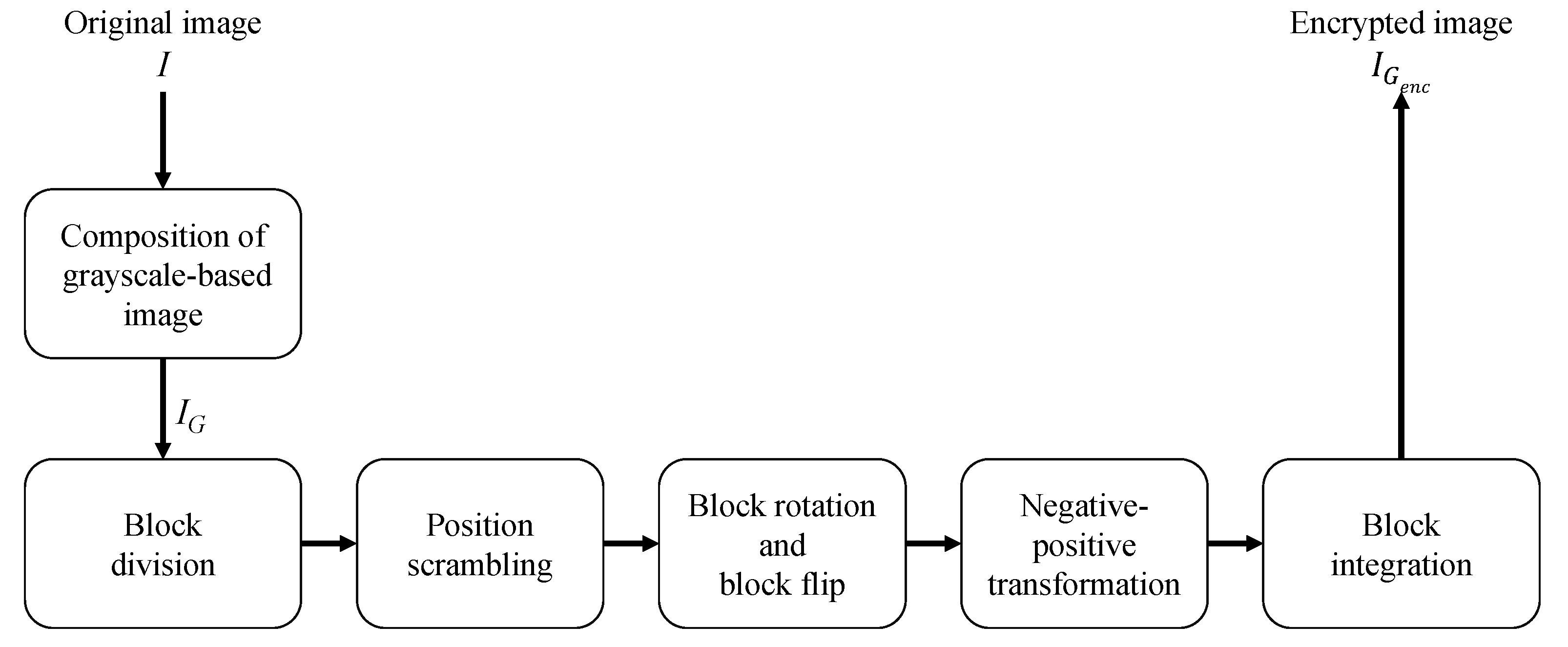


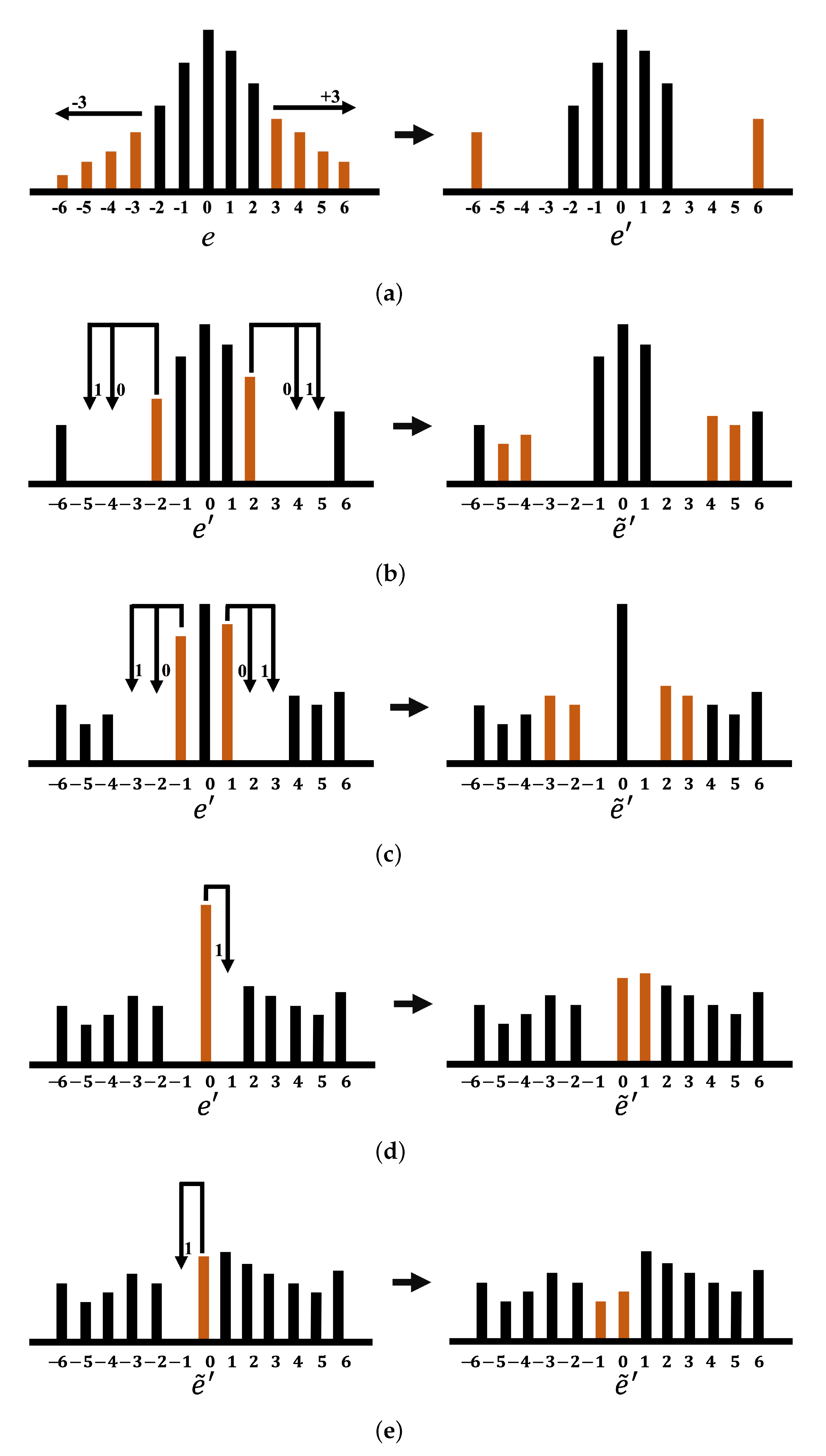

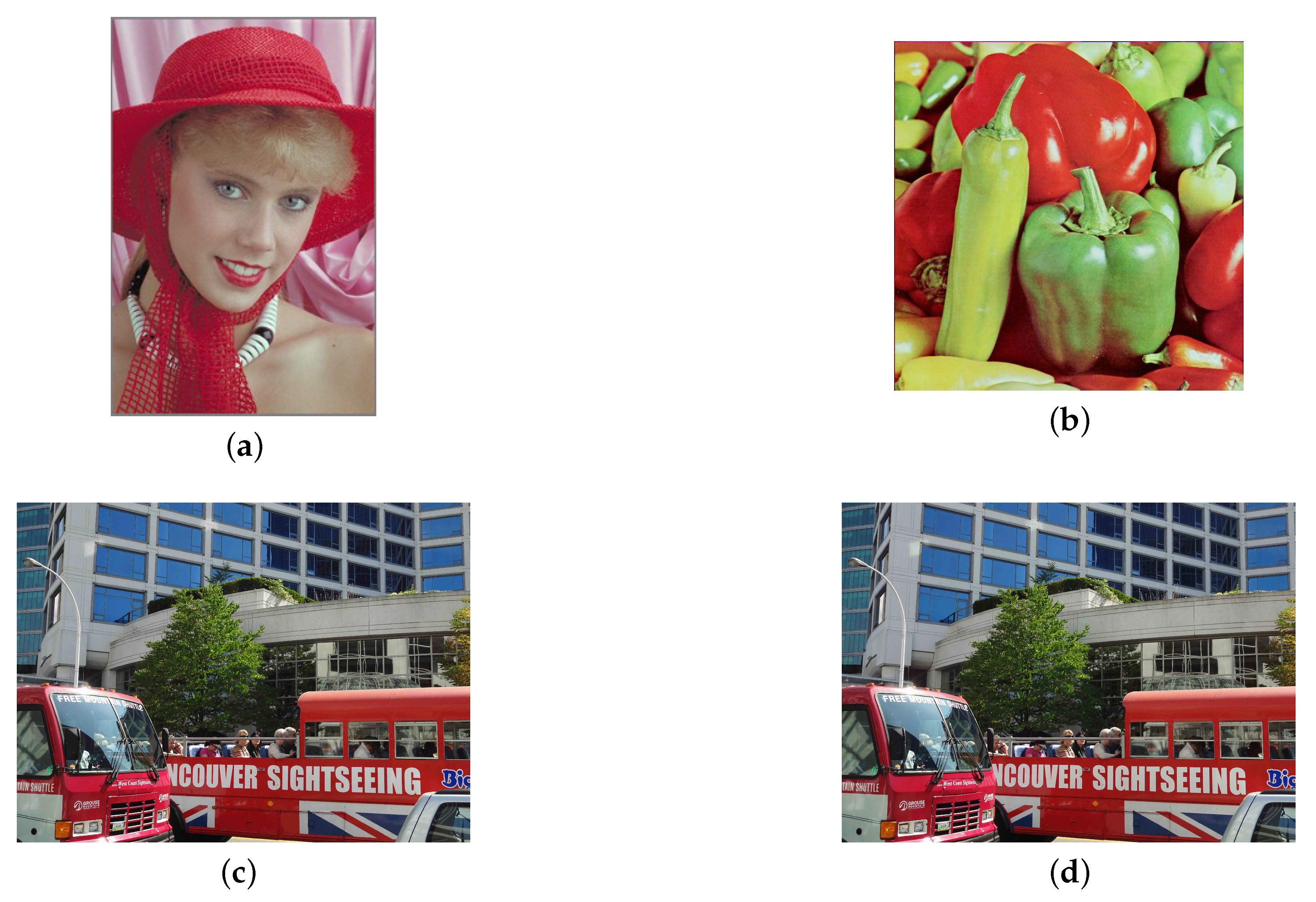

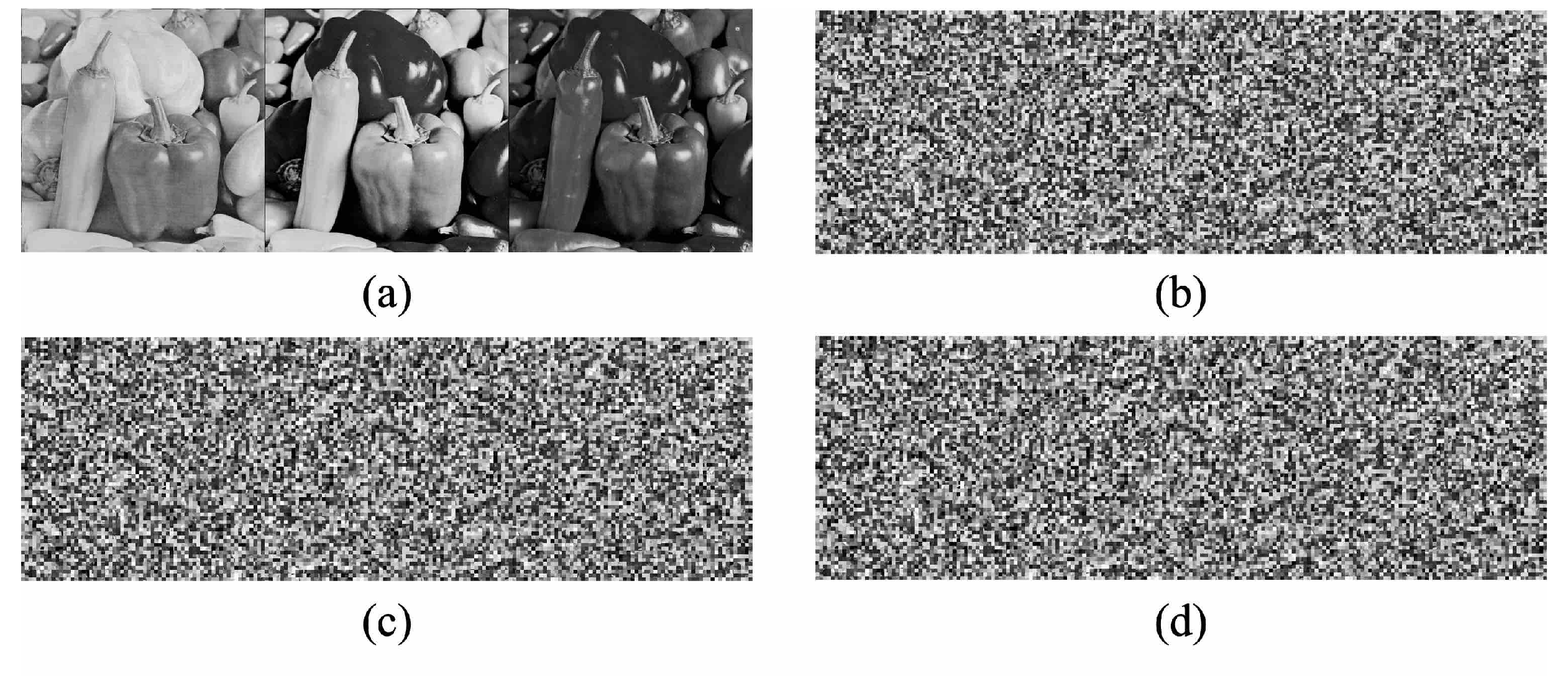
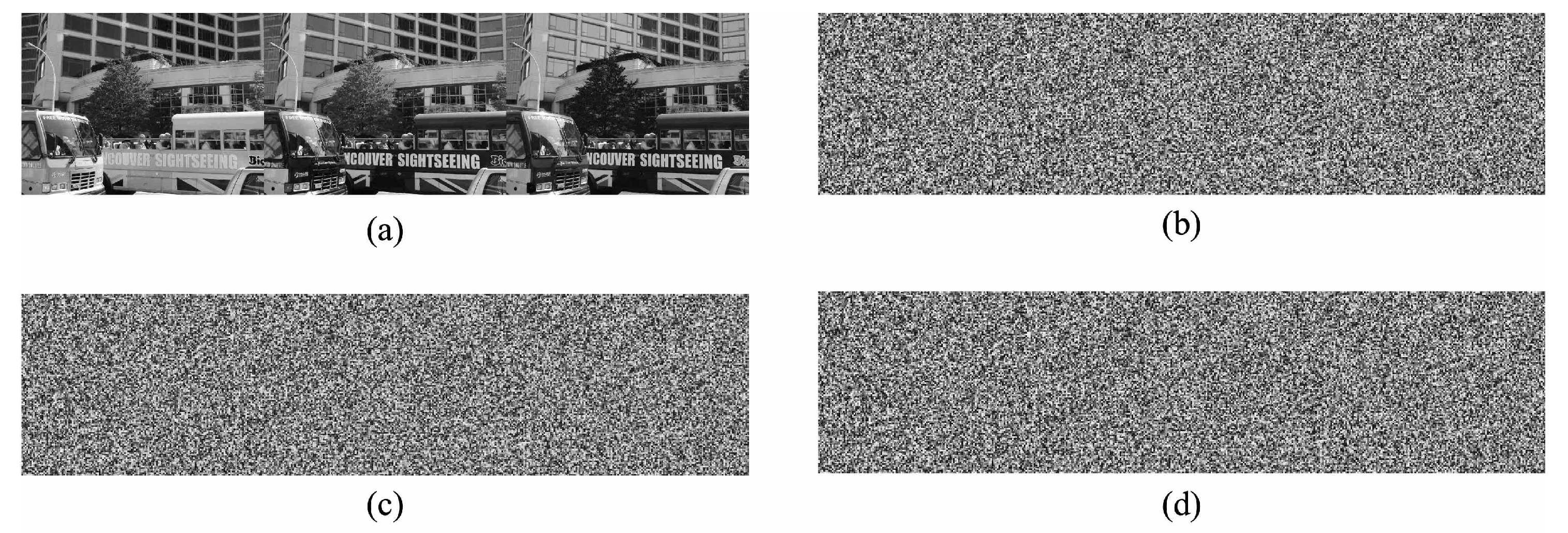
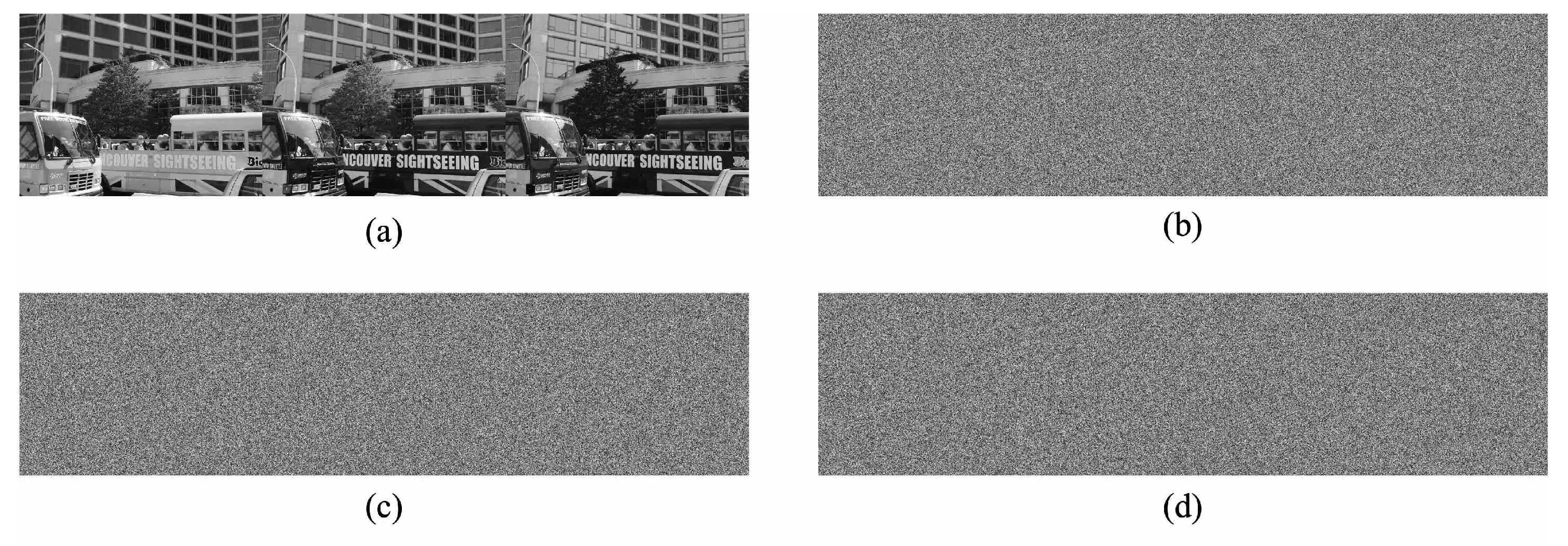

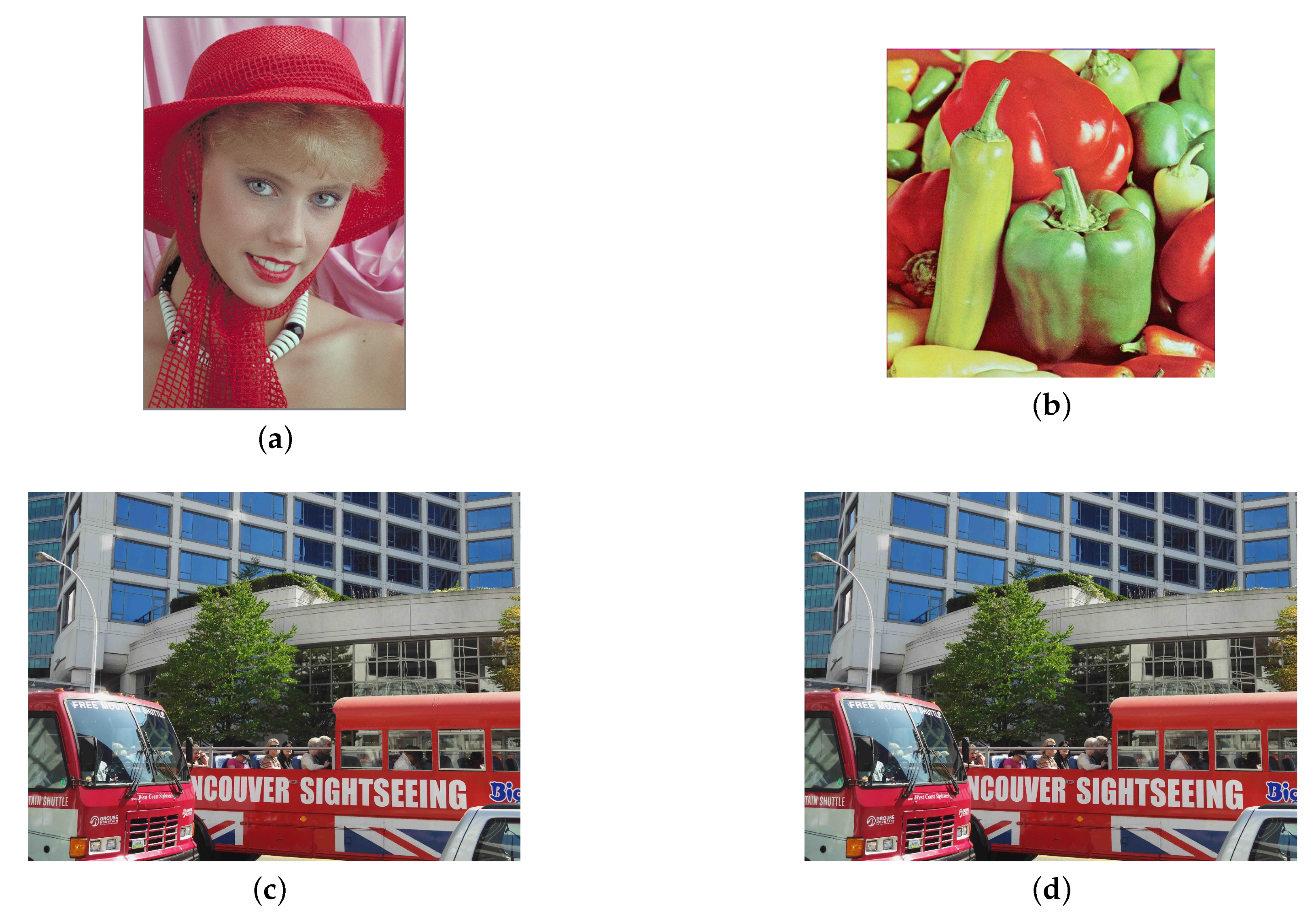
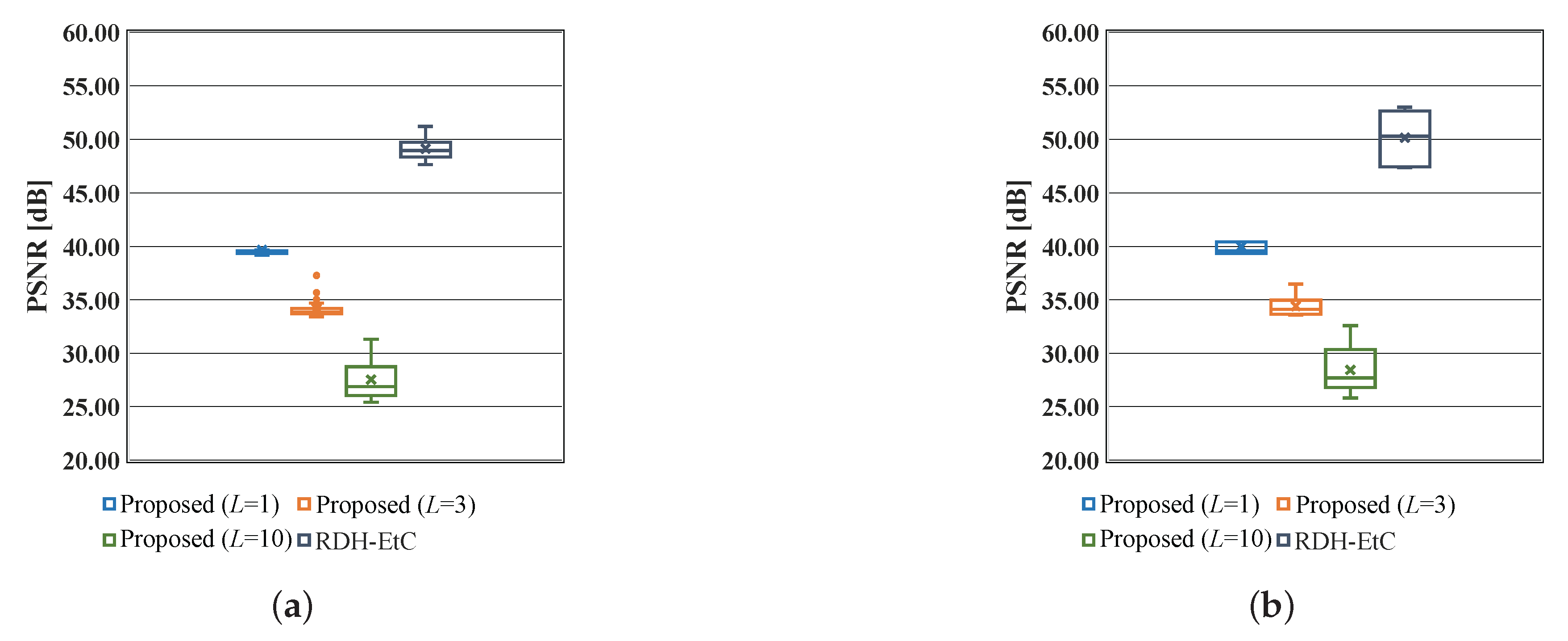
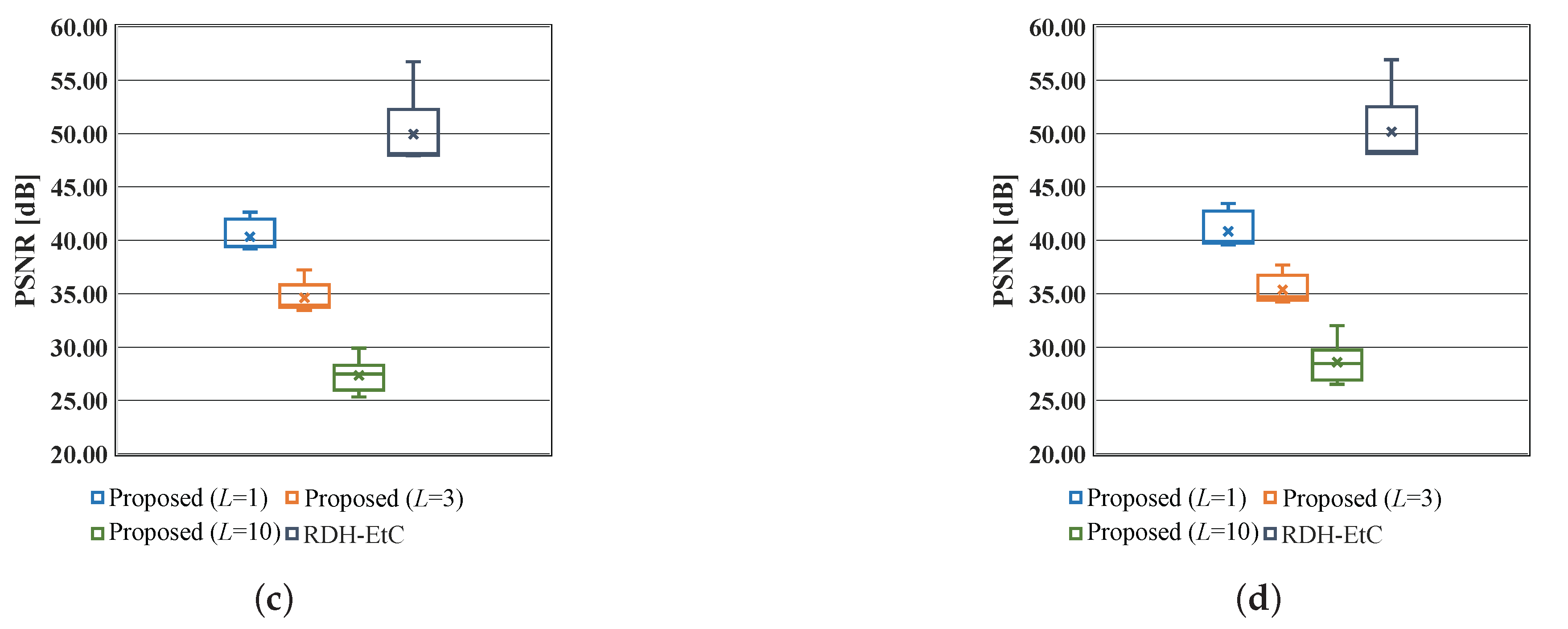
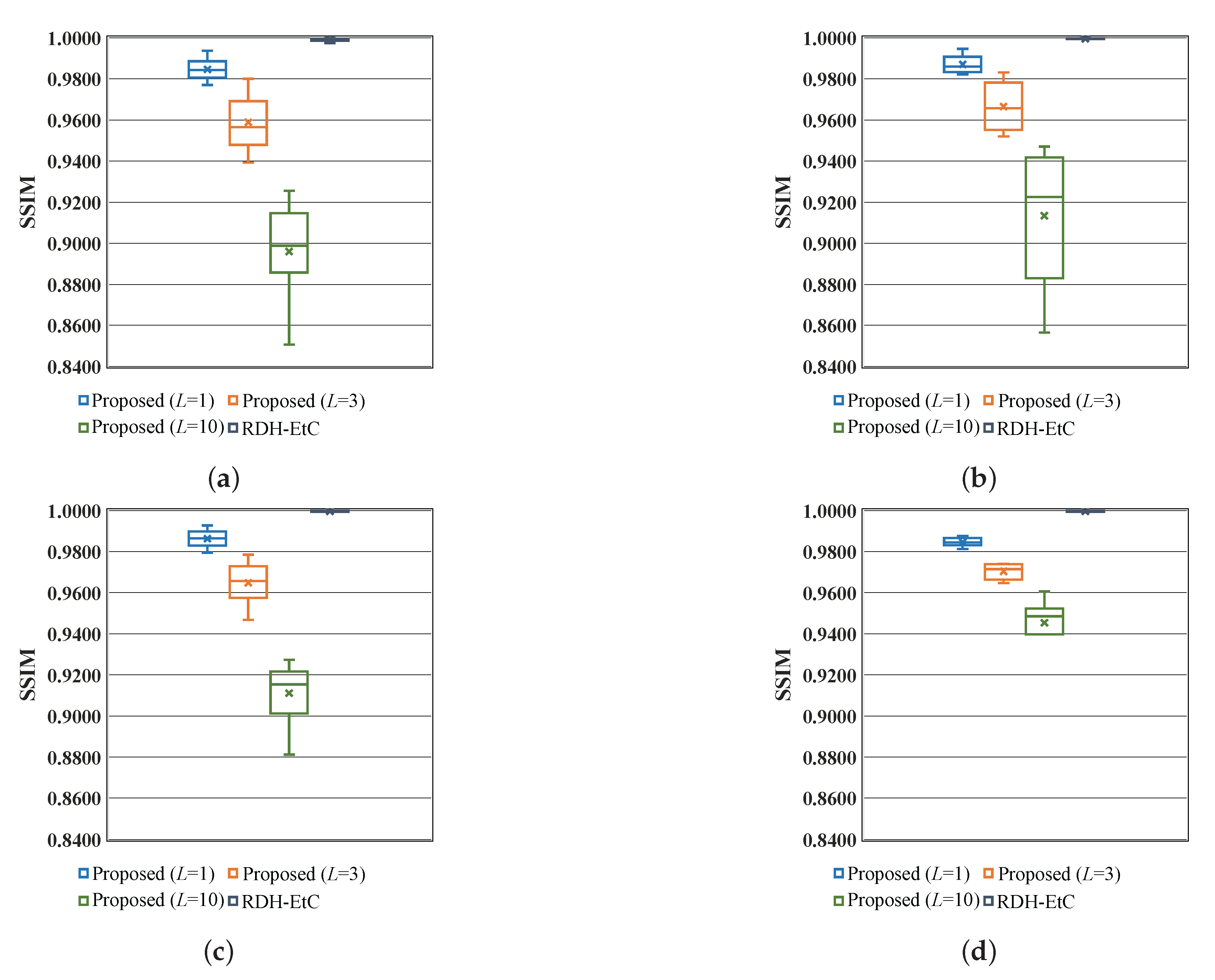
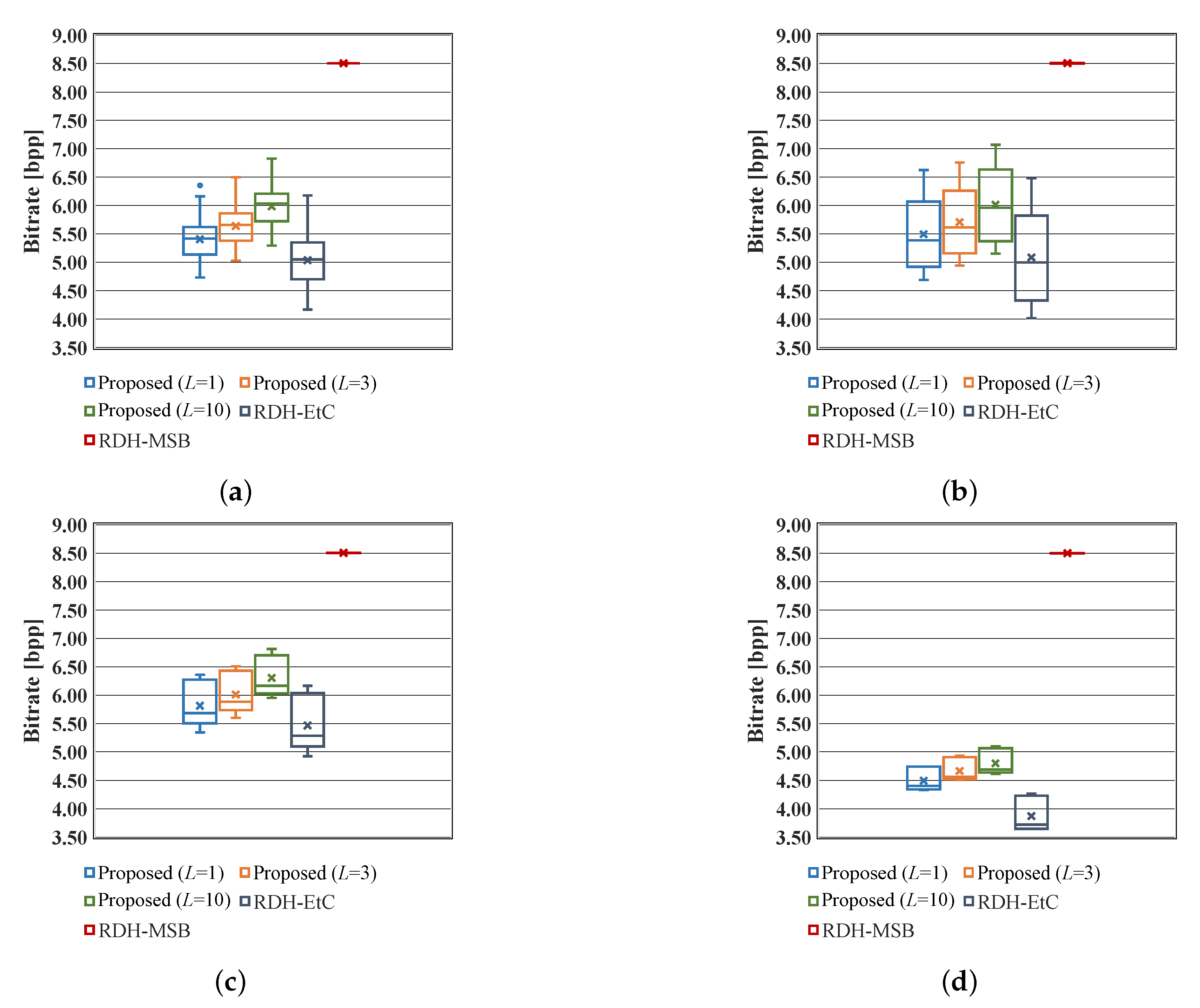
Publisher’s Note: MDPI stays neutral with regard to jurisdictional claims in published maps and institutional affiliations. |
© 2022 by the authors. Licensee MDPI, Basel, Switzerland. This article is an open access article distributed under the terms and conditions of the Creative Commons Attribution (CC BY) license (https://creativecommons.org/licenses/by/4.0/).
Share and Cite
Motomura, R.; Imaizumi, S.; Kiya, H. A Reversible Data-Hiding Method with Prediction-Error Expansion in Compressible Encrypted Images. Appl. Sci. 2022, 12, 9418. https://doi.org/10.3390/app12199418
Motomura R, Imaizumi S, Kiya H. A Reversible Data-Hiding Method with Prediction-Error Expansion in Compressible Encrypted Images. Applied Sciences. 2022; 12(19):9418. https://doi.org/10.3390/app12199418
Chicago/Turabian StyleMotomura, Ryota, Shoko Imaizumi, and Hitoshi Kiya. 2022. "A Reversible Data-Hiding Method with Prediction-Error Expansion in Compressible Encrypted Images" Applied Sciences 12, no. 19: 9418. https://doi.org/10.3390/app12199418
APA StyleMotomura, R., Imaizumi, S., & Kiya, H. (2022). A Reversible Data-Hiding Method with Prediction-Error Expansion in Compressible Encrypted Images. Applied Sciences, 12(19), 9418. https://doi.org/10.3390/app12199418











